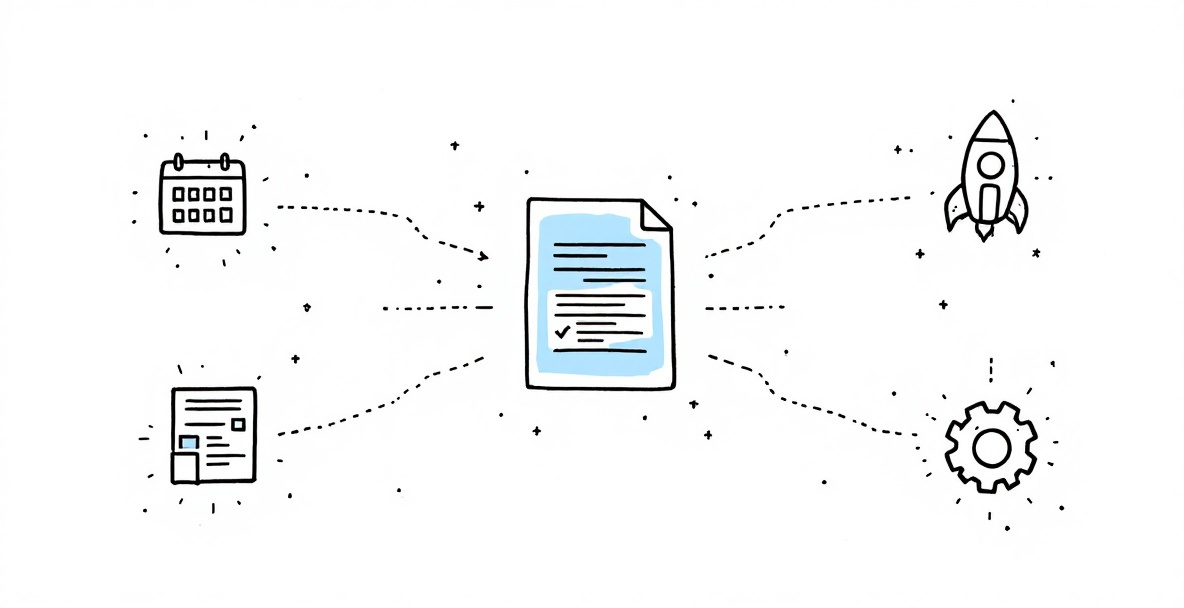In the race to capture audience attention, content creation has become both the cornerstone of digital marketing and its biggest bottleneck. As we approach 2025, businesses face mounting pressure to produce more content across more channels—all while maintaining quality and relevance. According to recent research from the Content Marketing Institute, the demands on content teams continue to increase annually. The traditional publishing approach, with its labor-intensive workflows and manual processes, simply can't keep pace with today's content demands. This is where automation steps in, not just as a productivity tool but as a complete paradigm shift in how we conceptualize, create, and distribute content.
The Content Creation Bottleneck: Why Traditional Publishing is Holding You Back

Traditional content creation workflows involve multiple touchpoints, numerous stakeholders, and countless hours of work. From ideation to publication, each piece typically passes through writers, editors, designers, and SEO specialists before finally reaching your audience. This approach worked in an era when digital content demands were modest, but today's digital ecosystem requires something far more agile.
The limitations of traditional publishing aren't just inconvenient—they're actively preventing businesses from capitalizing on opportunities. When your team spends weeks producing content that should take days, you miss critical market moments and trending topics. Your competitors who leverage automation gain the advantage of being first to market with relevant content, capturing search traffic and audience attention while your content is still stuck in review cycles.
The Real Cost of Manual Content Production
The expenses associated with manual content creation extend far beyond just the salaries of your content team. When calculating the true cost of traditional publishing, you need to consider several hidden factors that drain resources and limit growth potential.
Time is perhaps the most precious resource that manual processes consume. A typical blog post can require 6-8 hours for research, writing, editing, and formatting—before it even reaches the publication stage. Multiply this by dozens or hundreds of pieces per month, and you're looking at thousands of hours annually dedicated to content production alone.
Opportunity cost represents another significant expense. While your team is bogged down with repetitive tasks like formatting, basic research, and distribution setup, they're unable to focus on high-value strategic activities that could drive your business forward. The creativity, subject matter expertise, and strategic thinking that could differentiate your content are instead diluted by process management.
Quality inconsistency also plagues manual content production. When content creation depends heavily on individual contributors, maintaining a consistent brand voice and quality standard becomes extremely challenging. This inconsistency can damage brand perception and undermine audience trust over time.
The Automation Revolution in Content Publishing
Content automation has evolved dramatically from its early days of simplistic text generation. Today's advanced content publishing platforms leverage sophisticated AI to handle everything from research and content ideation to distribution and performance tracking. Recent studies on AI content generation capabilities show remarkable advances in quality and coherence. The result is a streamlined workflow that can reduce content production time by up to 70% while maintaining—and often improving—quality standards.
Modern automation solutions don't replace human creativity; they amplify it. By taking over repetitive, time-consuming tasks, these tools free your team to focus on strategy, creative direction, and the human elements that truly differentiate content. Writers can concentrate on crafting compelling narratives while automation handles research, SEO optimization, and technical publishing requirements.
At SeoFlow, we've witnessed firsthand how automation transforms content operations. Businesses that implement our AI-powered content platform typically see production capacity increase by 3-5x within the first month, without adding headcount. This dramatic efficiency boost allows them to explore new content formats, test different channels, and respond rapidly to market opportunities—advantages that manual processes simply cannot match.
Core Features of Modern Content Publishing Automation Solutions

As we approach 2025, the most effective content automation platforms have evolved beyond simple text generation to become comprehensive publishing ecosystems. These systems orchestrate the entire content lifecycle, from initial concept to distribution and performance measurement. Let's explore the core capabilities that define truly transformative automation solutions.
AI-Powered Content Generation and Enhancement
At the heart of modern publishing automation is advanced AI technology that can understand context, maintain brand voice, and produce genuinely valuable content. Unlike earlier generation tools that created obvious "robot text," today's AI writing assistants can produce nuanced, informative content that resonates with human readers.
The key advantage of AI-powered content creation isn't just speed—it's the ability to intelligently enhance human-created content. AI systems can suggest improvements to headline effectiveness, recommend SEO optimizations without sacrificing readability, and even identify content gaps that might answer additional reader questions. This collaborative approach combines human creativity with machine efficiency.
Our platform at SeoFlow leverages multiple neural networks that work together to understand brand voice and create original content tailored to specific requirements. The system analyzes your existing top-performing content to identify patterns in tone, style, and structure, then applies these insights to new content creation. This means automation doesn't lead to generic content—instead, it helps strengthen and consistently apply your unique brand voice.
The most advanced solutions also support customizable content templates for different purposes. Whether you're creating product descriptions, blog posts, or social media updates, these templates ensure consistency while significantly reducing production time. They embed your brand guidelines, preferred structure, and tone preferences directly into the content creation process.
Multi-Channel Publishing Capabilities
Content doesn't exist in a vacuum—it needs to reach your audience across multiple platforms and formats. Leading automation solutions provide seamless multi-channel publishing capabilities that eliminate the tedious reformatting and manual distribution work that traditionally consumes marketing teams.
Comprehensive automation platforms integrate directly with content management systems, social media platforms, email marketing tools, and other distribution channels. This allows a single piece of content to be automatically formatted and optimized for each destination, whether that's your company blog, LinkedIn profile, or email newsletter.
SeoFlow integrates with WordPress, Ghost, Notion, and other publishing platforms to enable truly frictionless content distribution. Users can schedule and automate content delivery at optimal times for each channel, ensuring content reaches the right audience when they're most receptive. The system handles technical details like meta descriptions, featured images, and social sharing properties automatically.
The most powerful aspect of multi-channel automation is consistency. When your messaging remains cohesive across all platforms while still being optimized for each channel's unique requirements, you strengthen brand recognition and maximize engagement opportunities. This level of coordination is virtually impossible to achieve with manual processes.
Analytics and Performance Tracking
Content creation without measurement is essentially shooting in the dark. Modern automation platforms close the loop by incorporating robust analytics capabilities that track performance across all distribution channels and feed insights back into the content creation process.
Leading solutions provide unified dashboards that aggregate performance metrics from multiple sources, giving you comprehensive visibility into how content performs. Rather than switching between Google Analytics, social media insights, and email campaign reports, you can access consolidated metrics that show the complete picture of content effectiveness.
At SeoFlow, our analytics suite goes beyond basic metrics to identify patterns and opportunities for improvement. The system automatically surfaces insights about which topics, formats, and distribution channels generate the strongest results for your specific audience. These insights are then fed back into the content planning process, creating a continuous improvement loop.
Advanced performance tracking also enables automatic content optimization after publication. When the system detects underperforming content, it can suggest improvements to headlines, introductions, or calls-to-action based on what's working in similar successful pieces. This post-publication enhancement ensures even existing content continues to deliver value over time.
Implementing Advanced Content Creation Platforms: A Strategic Approach

Adopting content automation isn't simply about installing new software—it requires thoughtful implementation to achieve maximum benefit. Organizations that approach automation strategically see dramatically better results than those who implement tools without clear objectives. Here's how to develop an effective implementation strategy.
Assessing Your Content Automation Needs
Before selecting a content automation solution, conducting a thorough assessment of your current content operations is crucial. This analysis helps identify specific pain points and opportunities where automation can deliver the greatest impact.
Start by mapping your existing content workflow from ideation to publication and promotion. Document each step, noting the time required, personnel involved, and common bottlenecks. This process often reveals surprising inefficiencies—many organizations discover that content spends more time in review and approval cycles than in actual creation.
Next, evaluate your content goals against current production capacity. Are you able to create enough content to support your marketing objectives? Are certain content types or channels neglected due to resource constraints? B2B content marketing research indicates that most organizations struggle to create sufficient content for all their channels and buyer personas. Understanding these gaps helps prioritize which aspects of automation will deliver the most immediate value.
At SeoFlow, we typically begin client relationships with a comprehensive content audit that examines both production processes and outcomes. This assessment often reveals that teams spend up to 60% of their content time on tasks that could be partially or fully automated, such as research, formatting, and distribution setup. Identifying these opportunities creates a clear roadmap for implementation.
Finally, consider your team's strengths and preferences. Effective automation complements human capabilities rather than replacing them. The goal is to let your creative team members focus on high-value activities while automation handles repetitive tasks. This human-centered approach leads to higher adoption rates and better overall results.
Integration and Training Best Practices
Successfully implementing content automation requires thoughtful integration with existing systems and comprehensive training for team members. The technical and human elements must work in harmony to realize the full potential of automation tools.
From a technical perspective, prioritize solutions that offer robust API connections and pre-built integrations with your existing martech stack. The most powerful automation occurs when systems can share data and triggers seamlessly. For example, when your CRM detects increased interest in a particular product, your content automation platform should be able to automatically schedule relevant content about that product.
Training should focus not just on tool functionality but on the new workflow possibilities that automation enables. Team members need to understand how automation changes their role—typically elevating it from production to strategy and oversight. At SeoFlow, we find that implementation success correlates directly with how well teams understand this role evolution.
Change management is perhaps the most overlooked aspect of automation implementation. Content teams may initially perceive automation as a threat rather than an enhancement to their work. Address these concerns by emphasizing how automation handles mundane tasks so team members can focus on the creative aspects they enjoy most. Celebrate early wins and share specific examples of how automation creates opportunities for more strategic, satisfying work.
Maximizing ROI with Content Publishing Automation

The business case for content automation becomes increasingly compelling as organizations recognize the full scope of benefits beyond simple productivity gains. When implemented strategically, automation delivers substantial return on investment across multiple dimensions.
Scaling Content Production Efficiently
One of the most immediate benefits of automation is the ability to dramatically scale content production without proportionally increasing resources. This capability transforms content from a limited tactical asset to a true strategic advantage that can be deployed across markets, products, and customer segments.
With automation handling research, initial drafting, and distribution tasks, teams can produce 3-5 times more content with the same resources. This scaling capability allows businesses to comprehensively cover their industry, creating content for every relevant keyword, topic, and customer question. The result is dramatically improved organic visibility and audience engagement.
The quality consistency that comes with automation further enhances scaling benefits. When content follows proven structures and incorporates best practices automatically, you eliminate the quality variance that typically occurs when scaling through additional writers or outsourcing. Your thousandth article maintains the same standards as your first, creating a cohesive brand experience.
Enterprise content trends for 2025 suggest that content volume demands will continue to grow exponentially, making scalable production capabilities essential. SeoFlow clients regularly report that automation enables them to expand into new content territories that were previously unfeasible. Whether it's creating content in multiple languages, developing detailed resources for niche audience segments, or maintaining separate content streams for different product lines, automation makes comprehensive content strategies achievable.
Optimizing Resource Allocation
Beyond simple productivity gains, content automation enables strategic reallocation of resources from production to higher-value activities that drive business growth. This shift represents perhaps the most significant long-term benefit of automation adoption.
When automation handles routine content production tasks, marketing leaders can redirect team talent toward strategic initiatives like developing original research, creating thought leadership, and building relationships with industry influencers. These high-value activities deliver disproportionate returns but are often neglected when teams are overwhelmed with basic content production demands.
Financial resources also shift from quantity to quality. Rather than hiring additional writers to increase output, companies can invest in specialized expertise that elevates content strategy. The result is content that not only ranks well but genuinely advances business objectives by positioning the company as an authoritative industry voice.
At SeoFlow, we've observed that the most successful clients use automation as an opportunity to fundamentally rethink their content investment strategy. Rather than viewing automation simply as a way to do more of the same, they recognize it as a catalyst for evolving their entire approach to content. This strategic mindset maximizes ROI by capturing both efficiency gains and new growth opportunities.
Future-Proofing Your Content Strategy: Next Steps for 2025 and Beyond
As we look toward 2025 and beyond, content automation will continue evolving from a competitive advantage to a fundamental business requirement. Organizations that proactively adapt their strategies now will be well-positioned for the next wave of digital transformation.
The content landscape of 2025 will be characterized by even greater channel proliferation, increasing audience expectations for personalization, and more sophisticated competition. Preparing for this environment requires not just adopting current automation tools but developing an adaptable approach that can evolve with technology and market dynamics.
Emerging technologies like generative AI will continue to enhance automation capabilities, enabling more nuanced content creation and deeper audience personalization. Organizations should develop governance frameworks that allow them to rapidly incorporate these innovations while maintaining brand standards and ethical content practices.
Key Implementation Takeaways
Successful content automation implementation follows a clear pattern that organizations can adapt to their specific needs. These fundamental principles apply regardless of industry or organization size.
Start with clear objectives rather than technology. Define what success looks like—whether that's increased production volume, expanded channel coverage, or freed-up resources for strategic initiatives. These objectives should drive your technology selection and implementation approach.
Adopt an incremental approach by automating one content type or channel at a time. This method allows you to refine your processes, demonstrate success, and build organizational confidence before expanding. Many SeoFlow clients begin with automating blog content before moving to more specialized formats like product descriptions or technical documentation.
Maintain a strong human oversight component, especially in the early stages. The most successful automation implementations include clear review processes that gradually evolve as the system demonstrates reliability. This approach ensures quality while building team trust in the automation capabilities.
Focus on results rather than activity. As automation reduces the manual effort required for content production, shift your measurement framework toward outcome metrics like engagement, conversion, and revenue attribution. This adjustment helps teams focus on impact rather than output volume.
Getting Started with Automation
The journey toward content automation begins with an honest assessment of your current state and a clear vision of your desired future. This foundation ensures your automation initiative delivers meaningful business value rather than simply adding another tool to your stack.
Begin by conducting a content audit that evaluates both your production process and content performance. Identify specific friction points and opportunities where automation could deliver immediate value. This assessment provides the data needed to build a compelling business case and prioritize implementation phases.
Research potential solutions with your specific needs in mind. Evaluate not just current capabilities but development roadmaps, integration options, and company stability. The right automation partner should align with your long-term content strategy and demonstrate a commitment to continuous innovation.
At SeoFlow, we recommend starting with a pilot project focused on a specific content type or channel. This approach allows you to demonstrate concrete results quickly while minimizing disruption to existing workflows. A successful pilot builds organizational confidence and creates momentum for broader implementation.
Throughout the process, maintain focus on the end goal: creating better content experiences for your audience. Automation is ultimately a means to this end, enabling your team to produce more relevant, timely, and valuable content for the people you serve.
The content landscape will continue evolving rapidly, but organizations that establish strong automation foundations now will be positioned to adapt and thrive. By embracing these technologies and approaches, you can transform content from a resource constraint to a powerful growth engine for your business.
Ready to revolutionize your content production for 2025 and beyond? Explore how SeoFlow can help you automate your content workflow, increase production capacity, and deliver consistently outstanding content that drives real business results.




